Timothy Gregory
QuasiNav: Asymmetric Cost-Aware Navigation Planning with Constrained Quasimetric Reinforcement Learning
Oct 22, 2024Abstract:Autonomous navigation in unstructured outdoor environments is inherently challenging due to the presence of asymmetric traversal costs, such as varying energy expenditures for uphill versus downhill movement. Traditional reinforcement learning methods often assume symmetric costs, which can lead to suboptimal navigation paths and increased safety risks in real-world scenarios. In this paper, we introduce QuasiNav, a novel reinforcement learning framework that integrates quasimetric embeddings to explicitly model asymmetric costs and guide efficient, safe navigation. QuasiNav formulates the navigation problem as a constrained Markov decision process (CMDP) and employs quasimetric embeddings to capture directionally dependent costs, allowing for a more accurate representation of the terrain. This approach is combined with adaptive constraint tightening within a constrained policy optimization framework to dynamically enforce safety constraints during learning. We validate QuasiNav across three challenging navigation scenarios-undulating terrains, asymmetric hill traversal, and directionally dependent terrain traversal-demonstrating its effectiveness in both simulated and real-world environments. Experimental results show that QuasiNav significantly outperforms conventional methods, achieving higher success rates, improved energy efficiency, and better adherence to safety constraints.
SERN: Simulation-Enhanced Realistic Navigation for Multi-Agent Robotic Systems in Contested Environments
Oct 22, 2024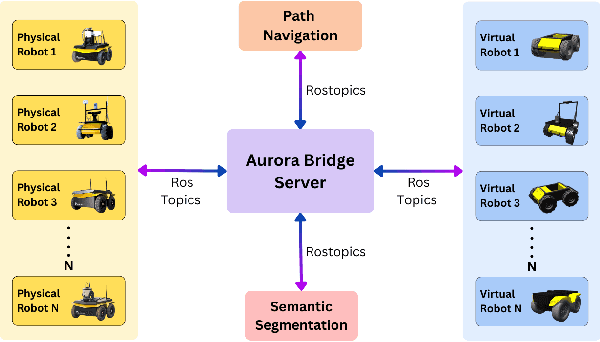
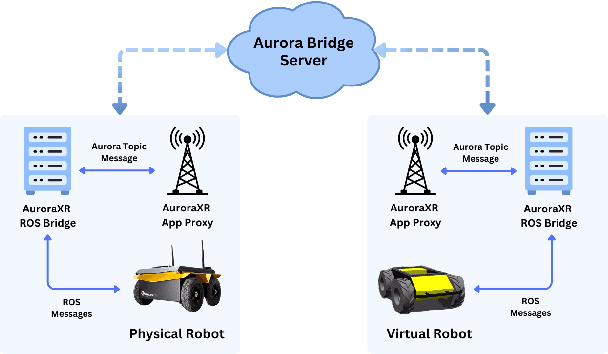
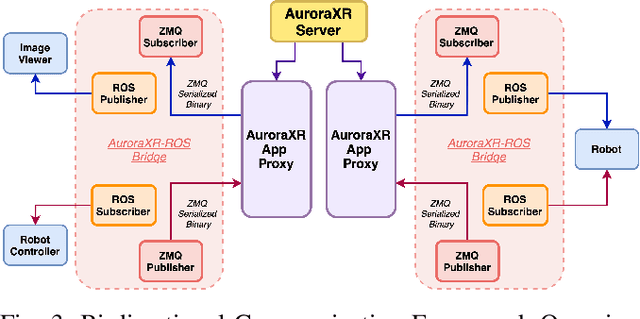
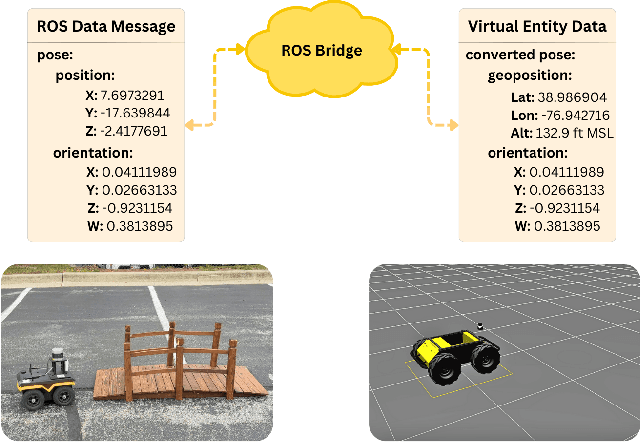
Abstract:The increasing deployment of autonomous systems in complex environments necessitates efficient communication and task completion among multiple agents. This paper presents SERN (Simulation-Enhanced Realistic Navigation), a novel framework integrating virtual and physical environments for real-time collaborative decision-making in multi-robot systems. SERN addresses key challenges in asset deployment and coordination through a bi-directional communication framework using the AuroraXR ROS Bridge. Our approach advances the SOTA through accurate real-world representation in virtual environments using Unity high-fidelity simulator; synchronization of physical and virtual robot movements; efficient ROS data distribution between remote locations; and integration of SOTA semantic segmentation for enhanced environmental perception. Our evaluations show a 15% to 24% improvement in latency and up to a 15% increase in processing efficiency compared to traditional ROS setups. Real-world and virtual simulation experiments with multiple robots demonstrate synchronization accuracy, achieving less than 5 cm positional error and under 2-degree rotational error. These results highlight SERN's potential to enhance situational awareness and multi-agent coordination in diverse, contested environments.
TopoNav: Topological Navigation for Efficient Exploration in Sparse Reward Environments
Feb 06, 2024
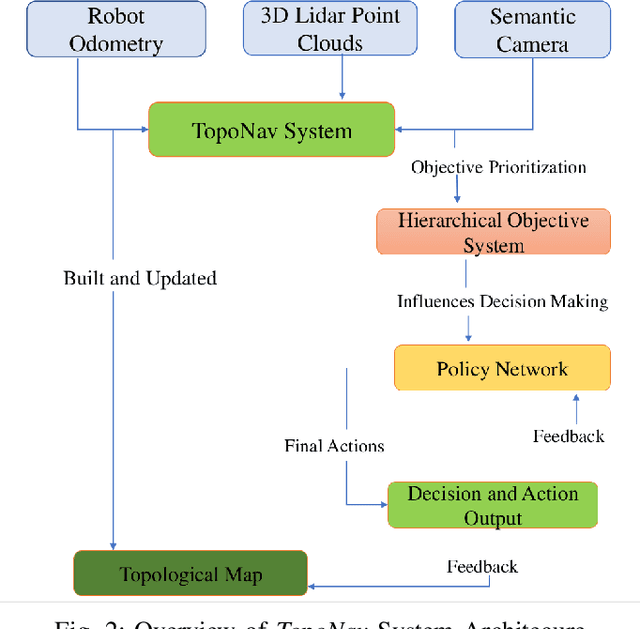


Abstract:Autonomous robots exploring unknown areas face a significant challenge -- navigating effectively without prior maps and with limited external feedback. This challenge intensifies in sparse reward environments, where traditional exploration techniques often fail. In this paper, we introduce TopoNav, a novel framework that empowers robots to overcome these constraints and achieve efficient, adaptable, and goal-oriented exploration. TopoNav's fundamental building blocks are active topological mapping, intrinsic reward mechanisms, and hierarchical objective prioritization. Throughout its exploration, TopoNav constructs a dynamic topological map that captures key locations and pathways. It utilizes intrinsic rewards to guide the robot towards designated sub-goals within this map, fostering structured exploration even in sparse reward settings. To ensure efficient navigation, TopoNav employs the Hierarchical Objective-Driven Active Topologies framework, enabling the robot to prioritize immediate tasks like obstacle avoidance while maintaining focus on the overall goal. We demonstrate TopoNav's effectiveness in simulated environments that replicate real-world conditions. Our results reveal significant improvements in exploration efficiency, navigational accuracy, and adaptability to unforeseen obstacles, showcasing its potential to revolutionize autonomous exploration in a wide range of applications, including search and rescue, environmental monitoring, and planetary exploration.
HeteroEdge: Addressing Asymmetry in Heterogeneous Collaborative Autonomous Systems
May 05, 2023



Abstract:Gathering knowledge about surroundings and generating situational awareness for IoT devices is of utmost importance for systems developed for smart urban and uncontested environments. For example, a large-area surveillance system is typically equipped with multi-modal sensors such as cameras and LIDARs and is required to execute deep learning algorithms for action, face, behavior, and object recognition. However, these systems face power and memory constraints due to their ubiquitous nature, making it crucial to optimize data processing, deep learning algorithm input, and model inference communication. In this paper, we propose a self-adaptive optimization framework for a testbed comprising two Unmanned Ground Vehicles (UGVs) and two NVIDIA Jetson devices. This framework efficiently manages multiple tasks (storage, processing, computation, transmission, inference) on heterogeneous nodes concurrently. It involves compressing and masking input image frames, identifying similar frames, and profiling devices to obtain boundary conditions for optimization.. Finally, we propose and optimize a novel parameter split-ratio, which indicates the proportion of the data required to be offloaded to another device while considering the networking bandwidth, busy factor, memory (CPU, GPU, RAM), and power constraints of the devices in the testbed. Our evaluations captured while executing multiple tasks (e.g., PoseNet, SegNet, ImageNet, DetectNet, DepthNet) simultaneously, reveal that executing 70% (split-ratio=70%) of the data on the auxiliary node minimizes the offloading latency by approx. 33% (18.7 ms/image to 12.5 ms/image) and the total operation time by approx. 47% (69.32s to 36.43s) compared to the baseline configuration (executing on the primary node).
 Add to Chrome
Add to Chrome Add to Firefox
Add to Firefox Add to Edge
Add to Edge